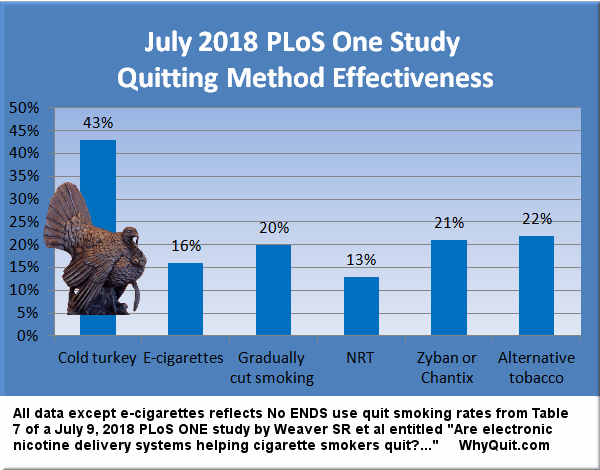
Cold turkey quitting still king
UPDATE: Just 16 days after this article was written, a July 31, 2013 U.S. Gallup Poll found that more smokers quit smoking cold turkey than by all other methods combined, that after 29 years and billions spent on marketing that only 1 in 100 ex-smokers would credit nicotine gum for their success.
Nicotine replacement products or NRT (the nicotine patch, gum, lozenge, spray and inhaler) demonstrated greater efficacy than placebo look-a-likes inside more than two hundred randomized clinical trials. But clinical efficacy can exist at the exact same time that real-world effectiveness does not. Exhibit "A": NRT.
Why? Because placebo isn't a real quitting method. Because those 200 randomized studies were not blind as claimed, as roughly 3 times as many placebo group members are able to correctly declare their assignment within 24 to 48 hours (peak withdrawal) as guess wrong.
Repeated stop smoking attempts transform quitters into experts at recognizing withdrawal's onset. In the NRT group, nicotine stimulates brain dopamine pathways producing a wanting relief sensation. It's the same wanting relief felt by never-smokers upon eating food when hungry. It's why those 200 trials measured expectations, not product worth.

Thus, it should come as no surprise that once NRT's novelty wore off that it started getting clobbered by cold turkey in long-term population level effectiveness studies. What's shocking is that senior government health officials continue to ignore NRT's failure. What's disturbing is that government quit smoking sites continue to falsely assert that NRT "doubles your chances," when clearly the word "your" suggests real-world effectiveness, not efficacy over placebo.
In Doran 2006, a study which monitored and tracked the smoking patients of 1,000 family practice physicians, cold turkey nearly doubled quitting rates seen in nicotine patch, gum, inhaler and Zyban quitters.
That doubling matches what's seen when cold turkey is compared to real-world gradual weaning or reduction quitting (see Cheong 2007). As the FDA recognizes, replacement nicotine itself is about weaning: a gradual reduction in the number of pieces of nicotine gum or lozenges over time, or stepping down from a 21mg nicotine patch, to 14mg, to 7mg and then zero.
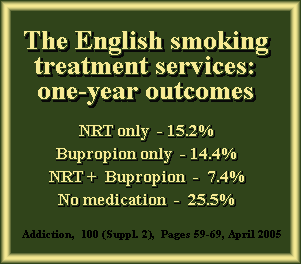 Surprisingly, few real-world studies isolate and evaluate cold turkey quitting alone. Normally its effectiveness is diminished by being included within larger groupings such as "unassisted," where it gets watered down by less effective gradual weaning, or even larger groupings such as "non-NRT," which not only includes weaning but every sham quitting method on the market today.
Surprisingly, few real-world studies isolate and evaluate cold turkey quitting alone. Normally its effectiveness is diminished by being included within larger groupings such as "unassisted," where it gets watered down by less effective gradual weaning, or even larger groupings such as "non-NRT," which not only includes weaning but every sham quitting method on the market today.
For example, in Pierce 2012, quitting method survey data was analyzed after one year, with "unassisted" quitting rates being compared to NRT for both light smokers (< 15 cigarettes per day) and heavy smokers (> 15 per day).
The results? Unassisted light smokers were 27 percent more successful than NRT at three months and beyond, generating a 26 percent unassisted quitting rate versus 19 percent for "NRT or prescription medication" quitters. Among heavy smokers, unassisted quitters were 40 percent more likely to succeed, producing a 15 percent unassisted rate compared to 9 percent for NRT.
There have also been a number of indirect cold turkey victories. In West 2006 and Ferguson 2009, unplanned attempts were roughly twice as successful as planned ones. As the authors note, NRT use requires planning.
Yet, the U.S. government's most popular quit smoking site, SmokeFree.gov, falsely asserts that NRT use "can double your chances of quitting for good." In that SmokeFree.gov makes 173 references to using "medication" or "medicine," while never once encouraging or supporting cold turkey, it should be renamed BuyMeds.now.
Even more troubling is the cold turkey bashing that occurs in SmokeFree.gov's Clearing the Air” quitting brochure. There, on PDF page 14, the booklet thrice lies to smokers:
"For some smokers 'going cold turkey' seems like the easiest way to quit. Just stop smoking and tell yourself you'll never light up again. This works for some smokers - usually those with the lowest level of nicotine dependence - but not many. Fewer than 5 percent of smokers can quit this way. Most people aren't prepared when smoking habits and withdrawal symptoms trigger an intense urge to smoke. Research shows that most smokers have more success with one of the assisted quit methods discussed below."
Pierce 2012 shatters the three highlighted falsehoods. In Pierce, unassisted quitters prevailed over both light and heavy smokers. And contrary to the frightening and ludicrous suggestion that fewer than 5% of smokers are capable of quitting cold turkey, 72 percent of all long-term successful quitters in Pierce quit unassisted (156 of 216).
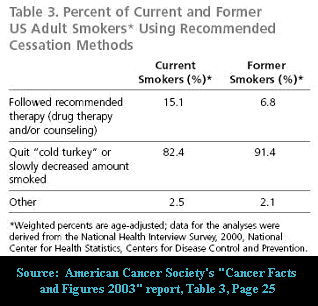 Doran
2006 evaluated cold turkey quitters. There, cold turkey was not only twice as effective as replacement nicotine, it accounted for a whopping 88 percent of all success stories.
Doran
2006 evaluated cold turkey quitters. There, cold turkey was not only twice as effective as replacement nicotine, it accounted for a whopping 88 percent of all success stories.
Regarding the falsehood that "most" smokers have more success with assisted methods, even NRT stakeholders are forced to admit that cold turkey annually generates more successful quitters than all other methods combined.
Enter the need for a voice that supports and encourages the dependent smoker's natural instincts to end nicotine use, instead of weeks or months spent toying with new methods of delivery. Enter WhyQuit.com, the Internet's most popular cold turkey motivation, education and support site.
Founded on July 15, 1999, today WhyQuit celebrates its 14th birthday. This totally free site is staffed entirely by volunteer nicotine cessation educators. It sells nothing, refuses advertisements and declines donations.
WhyQuit is home to nearly 500 free quit smoking videos, two popular free cold turkey quitting e-books (Never Take Another Puff and Freedom from Nicotine - The Journey Home), hundreds of original articles, and to (Turkeyville a Facebook cold turkey support group that's home to more than 13,000 members. WhyQuit also shares far too many tragic stories about young smoking victims, such as Deborah, Bryan and Noni.
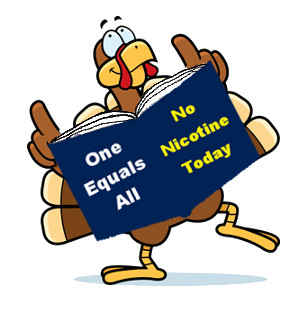 Since May 13, 2012, WhyQuit has successfully handled 45,565,345 server requests for 2,653,425 distinct IP addresses. During the past year
it has assisted roughly 2.5 times as many unique visitors as all "call attempts" made to the national 1-800-QUIT-NOW telephone quit smoking line (80,867 during 2012).
Since May 13, 2012, WhyQuit has successfully handled 45,565,345 server requests for 2,653,425 distinct IP addresses. During the past year
it has assisted roughly 2.5 times as many unique visitors as all "call attempts" made to the national 1-800-QUIT-NOW telephone quit smoking line (80,867 during 2012).
It did so at a total cost of $91.68 (website hosting charges) as compared to at least $54 million spent by the CDC on marketing designed in part to motivate quitline callers, where NRT is highly recommended and cold turkey strongly discouraged.
But in another important regard, WhyQuit has been a total failure. Despite scores of attempts, it has failed miserably in getting public health officials to stop ignoring the population level effectiveness evidence-base, to stop allowing “medication” stakeholders to author official government quitting policy, to motivate them to demand immediate evidence that real-world NRT isn't undercutting cessation and costing smokers lives, and to stop discouraging and start supporting abrupt nicotine cessation.
Each year more than 400,000 Americans complete the act of committing slow suicide via smoke's more than 200 toxins, that include 81 known carcinogens. Our nation should be at war with it's leading cause of preventable death. In fact, more smokers lose their lives to smoking every two years than the total number of U.S. combat deaths from all wars since our nation's founding (848,163).
So where are our health generals? And why since June 2000 has their failed and deadly battle plan remained unchanged? It was then that they invited paid pharmaceutical industry consultants to author official U.S. smoking cessation policy (see June 2000 U.S. Guideline PDF page187).
It was then and there, in one all consuming recommendation, that all government health officials were instantly transformed into nicotine salesmen, guaranteeing the pharmaceutical industry billions. Recommendation 7 decreed that henceforth, "except in the presence of contraindications, that NRT or bupropion should be used with all patients attempting to quit smoking" (see June 2000 Guideline, PDF page 4, Recommendation 7).
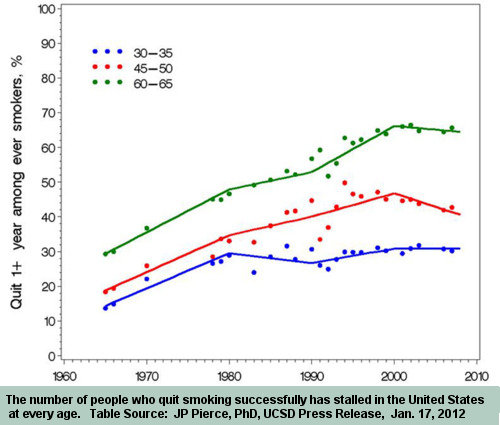
As more readily appreciated 13 years later, it was a stroke of corporate genius. Guideline recommendation 7 wasn't simply a recommendation. It was adopted in June 2000 by the U.S. Department of Health as official U.S. quitting policy. It instantly outlawed any government support for any stop smoking method that did not encourage use of pharmaceutical industry nicotine for all quitters.
Recommendation 7 effectively declared all methods and programs not offering NRT to all quitters as being "non-science based." It meant that government funding would no longer be expended to study existing non-medication methods, nor could they serve as arms or controls in studies. It locked cessation into medicinization.
Not only was every federal and state health official instantly transformed into a nicotine salesman, their quitting sites became nicotine marketing stores. The CDC's site claims that "all of these medications will at least double your chances of quitting and quitting for good," the AHRQ's that "using nicotine replacement almost doubles your chances of quitting," the NCI's that "NRT does work. NRT can double a smoker's chances of quitting smoking," and the VA's falsely tells vets that "all medicines for quitting smoking work equally well - they all double your chances of successfully quitting."
So where are America's health generals? And why have they hidden the government's only known population level quit smoking method analysis, the 2006 National Cancer Institute Hartman study? Is it because findings on PDF pages 13, 34, 35, 36 and 37 do not square with thousands of federal and state government assertions that NRT will "double your chances"?
What sense does it make to have effectively outlawed recommending use of our nation's most productive weapon? Why not instead order the immediate and intense study of successful abrupt nicotine cessation, in hopes of identifying and sharing its keys to success, thus refining, improving and making it even more productive and effective?
Why do our generals continue to defer to pharmaceutical industry stakeholders when they have long known that nearly the entire clinical trial evidence-base is built upon the fiction that placebo studies were blind? What explanation do our health generals offer as to why NRT prevails against placebo yet flounders against cold turkey?
I close with a prediction. The e-cigarette is not about nicotine cessation but nicotine replacement via a new high tech nicotine inhaler designed to mimic a cigarette. I predict that the e-cigarette will experience vastly more government support and backing during the next five years than nicotine cessation via cold turkey.
We are living cessation's dark ages. Things are horribly wrong when profits are elevated above lives, when health leadership lacks the wisdom and courage to lead, when our nation's most effective method for arresting chemical dependency upon nicotine is not only discouraged by government, but faces another giant step backwards.
